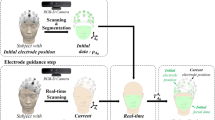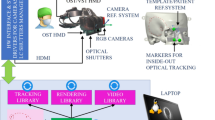Abstract
Purpose
Using existing stereoelectroencephalography (SEEG) electrode implantation surgical robot systems, it is difficult to intuitively validate registration accuracy and display the electrode entry points (EPs) and the anatomical structure around the electrode trajectories in the patient space to the surgeon. This paper proposes a prototype system that can realize video see-through augmented reality (VAR) and spatial augmented reality (SAR) for SEEG implantation. The system helps the surgeon quickly and intuitively confirm the registration accuracy, locate EPs and visualize the internal anatomical structure in the image space and patient space.
Methods
We designed and developed a projector-camera system (PCS) attached to the distal flange of a robot arm. First, system calibration is performed. Second, the PCS is used to obtain the point clouds of the surface of the patient’s head, which are utilized for patient-to-image registration. Finally, VAR is produced by merging the real-time video of the patient and the preoperative three-dimensional (3D) operational planning model. In addition, SAR is implemented by projecting the planning electrode trajectories and local anatomical structure onto the patient’s scalp.
Results
The error of registration, the electrode EPs and the target points are evaluated on a phantom. The fiducial registration error is \(0.25 \pm 0.23\) mm (max 1.22 mm), and the target registration error is \(0.62\pm 0.28\) mm (max 1.18 mm). The projection overlay error is \(0.75\pm 0.52\) mm, and the TP error after the pre-warped projection is \(0.82\pm 0.23\) mm. The TP error caused by a surgeon’s viewpoint deviation is also evaluated.
Conclusion
The presented system can help surgeons quickly verify registration accuracy during SEEG procedures and can provide accurate EP locations and internal structural information to the surgeon. With more intuitive surgical information, the surgeon may have more confidence and be able to perform surgeries with better outcomes.














Similar content being viewed by others
References
Cardinale F, Cossu M, Castana L, Casaceli G, Schiariti MP, Miserocchi A, Fuschillo D, Moscato A, Caborni C, Arnulfo G (2013) Stereoelectroencephalography: surgical methodology, safety, and stereotactic application accuracy in 500 procedures. Neurosurgery 72(3):353–366
Cossu M, Fuschillo D, Casaceli G, Pelliccia V, Castana L, Mai R, Francione S, Sartori I, Gozzo F, Nobili L (2015) Stereoelectroencephalography-guided radiofrequency thermocoagulation in the epileptogenic zone: a retrospective study on 89 cases. J Neurosurg 123(6):1358–1367
Nowell M, Rodionov R, Diehl B, Wehner T, Zombori G, Kinghorn J, Ourselin S, Duncan J, Miserocchi A, McEvoy A (2014) A novel method for implementation of frameless StereoEEG in epilepsy surgery. Neurosurgery 10(4):525
Faria C, Erlhagen W, Rito M, De Momi E, Ferrigno G, Bicho E (2015) Review of robotic technology for stereotactic neurosurgery. IEEE Rev Biomed Eng 8:125–137
Tagaytayan R, Kelemen A, Sik-Lanyi C (2016) Augmented reality in neurosurgery. Arch Med Sci. doi:10.5114/aoms.2016.58690
Besharati Tabrizi L, Mahvash M (2015) Augmented reality-guided neurosurgery: accuracy and intraoperative application of an image projection technique. J Neurosurg 123(1):206–211
Meola A, Cutolo F, Carbone M, Cagnazzo F, Ferrari M, Ferrari V (2016) Augmented reality in neurosurgery: a systematic review. Neurosurg Rev. doi:10.1007/s10143-016-0732-9
Kersten-Oertel M, Gerard I, Drouin S, Mok K, Sirhan D, Sinclair DS, Collins DL (2015) Augmented reality in neurovascular surgery: feasibility and first uses in the operating room. Int J Comput Assist Radiol Surg 10(11):1823–1836
González-Martínez J, Bulacio J, Thompson S, Gale J, Smithason S, Najm I, Bingaman W (2016) Technique, results, and complications related to robot-assisted stereoelectroencephalography. Neurosurgery 78(2):169–180
Watanabe E, Satoh M, Konno T, Hirai M, Yamaguchi T (2016) The trans-visible navigator: a see-through neuronavigation system using augmented reality. World Neurosurg 87:399–405
Kockro RA, Tsai YT, Ng I, Hwang P, Zhu C, Agusanto K, Hong LX, Serra L (2009) DEX - RAY: augmented reality neurosurgical navigation with a handheld video probe. Neurosurgery 65(4):795–808
Park H, Kang G-C, Lee M-H, Kim S-J, Park J-I (2005) Direct-projected augmented reality considering user’s viewpoint. In: Proceedings of international meeting on information display and exhibition, pp 748–751
Nicolau S, Soler L, Mutter D, Marescaux J (2011) Augmented reality in laparoscopic surgical oncology. Surg Oncol 20(3):189–201
Hennersperger C, Manus J, Navab N (2016) Mobile laserprojection in computer assisted neurosurgery. In: International conference on medical imaging and virtual reality. Springer, pp 151–162
Geng J (2011) Structured-light 3D surface imaging: a tutorial. Adv Opt Phot 3(2):128–160
Hartley R, Zisserman A (2003) Multiple view geometry in computer vision. Cambridge University Press, Cambridge
Moreno D, Taubin G (2012) Simple, accurate, and robust projector-camera calibration. In: 2012 Second international conference on 3D imaging, modeling, processing, visualization & transmission. IEEE, pp 464–471
Tsai RY, Lenz RK (1989) A new technique for fully autonomous and efficient 3D robotics hand/eye calibration. IEEE Trans on Robot Autom 5(3):345–358
Zhang Z (2000) A flexible new technique for camera calibration. IEEE Trans Patt Anal Mach Intell 22(11):1330–1334
Besl PJ, McKay ND (1992) Method for registration of 3-D shapes. In: Robotics-DL tentative. International society for optics and photonics, pp 586–606
Rusinkiewicz S, Levoy M (2001) Efficient variants of the ICP algorithm. In: 3-D Digital imaging and modeling. Proceedings. Third international conference on, 2001. IEEE, pp 145–152
Sielhorst T, Bichlmeier C, Heining SM, Navab N (2006) Depth perception—a major issue in medical AR: evaluation study by twenty surgeons. In: International conference on medical image computing and computer-assisted intervention. Springer, pp 364–372
Cheng O, Guangzhi W, Quan Z, Wei K, Hui D (2005) Evaluating harris method in camera calibration. In: Engineering in medicine and biology society. IEEE-EMBS 2005. 27th annual international conference of the. IEEE, pp 6383–6386
Zhu C, Liang X, Kockro R, Serra L (2004) Accuracy evaluation of an augmented reality enhanced surgical navigation system. In: International congress series. Elsevier, p 1329
Roessler K, Sommer B, Merkel A, Rampp S, Gollwitzer S, Hamer HM, Buchfelder M (2016) A frameless stereotactic implantation technique for depth electrodes in refractory epilepsy using intraoperative magnetic resonance imaging. World Neurosurg 94:206–210
Vakharia VN, Sparks R, O’Keeffe AG, Rodionov R, Miserocchi A, McEvoy A, Ourselin S, Duncan J (2017) Accuracy of intracranial electrode placement for stereoelectroencephalography: A systematic review and meta-analysis. Epilepsia 58(6):921–932
Krempien R, Hoppe H, Kahrs L, Daeuber S, Schorr O, Eggers G, Bischof M, Munter MW, Debus J, Harms W (2008) Projector-based augmented reality for intuitive intraoperative guidance in image-guided 3D interstitial brachytherapy. Int J Radiat Oncol BiolPhys 70(3):944–952
Acknowledgements
The authors acknowledge the support of the National Natural Science Foundation of China (61361160417, 81271735) and the Ministry of Science and Technology of China (2016YFC0105800, 2017YFA0205904).
Author information
Authors and Affiliations
Corresponding author
Ethics declarations
Conflict of interest
The authors declare that they have no conflict of interest.
Ethical approval
This article does not contain any studies with human participants or animals performed by any of the authors.
Informed consent
This article does not contain patient data.
Rights and permissions
About this article
Cite this article
Zeng, B., Meng, F., Ding, H. et al. A surgical robot with augmented reality visualization for stereoelectroencephalography electrode implantation. Int J CARS 12, 1355–1368 (2017). https://doi.org/10.1007/s11548-017-1634-1
Received:
Accepted:
Published:
Issue Date:
DOI: https://doi.org/10.1007/s11548-017-1634-1




